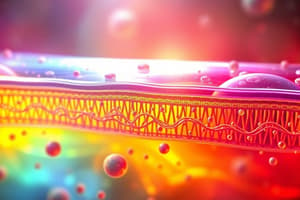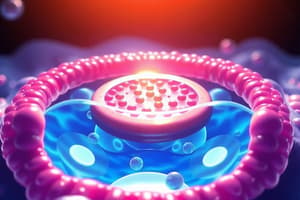Podcast
Questions and Answers
What type of molecules can easily diffuse through the membrane?
What type of molecules can easily diffuse through the membrane?
- Small polar molecules
- Gases and hydrophobic molecules (correct)
- Charged and large molecules
- Water and hydrophilic molecules
What facilitates the diffusion of water through the membrane?
What facilitates the diffusion of water through the membrane?
- Aquaporins (correct)
- Transporters
- Channels
- Integral membrane protein
What provides selectivity and facilitates transport across the membrane?
What provides selectivity and facilitates transport across the membrane?
- Diffusion gradient
- Aquaporins
- Integral membrane protein
- Transporters and channels (correct)
Which type of membrane protein forms tiny hydrophilic pores across the membrane to allow substances to pass via diffusion?
Which type of membrane protein forms tiny hydrophilic pores across the membrane to allow substances to pass via diffusion?
How do transporters shift small organic molecules or small inorganic ions from one side to another?
How do transporters shift small organic molecules or small inorganic ions from one side to another?
What determines exactly which solutes can pass in and out of a cell or organelle?
What determines exactly which solutes can pass in and out of a cell or organelle?
What represents the chemical potential caused by a barrier, and results in a unidirectional process?
What represents the chemical potential caused by a barrier, and results in a unidirectional process?
Which type of transport occurs down the concentration gradient without requiring energy?
Which type of transport occurs down the concentration gradient without requiring energy?
Which type of transporter uses previously established gradients to transport molecules against the concentration gradient?
Which type of transporter uses previously established gradients to transport molecules against the concentration gradient?
What powers the active transport against the concentration gradient by binding or hydrolysing ATP?
What powers the active transport against the concentration gradient by binding or hydrolysing ATP?
Which transporter only transports a single molecule?
Which transporter only transports a single molecule?
What is the result of the combination of electrical and chemical potentials?
What is the result of the combination of electrical and chemical potentials?
What is used to establish and maintain ion gradients such as Na+ and K+?
What is used to establish and maintain ion gradients such as Na+ and K+?
What causes the depolarization of the membrane potential by allowing the influx of Na+?
What causes the depolarization of the membrane potential by allowing the influx of Na+?
What percentage of total ATP is used by pumps like the sodium and potassium pump to establish and maintain gradients?
What percentage of total ATP is used by pumps like the sodium and potassium pump to establish and maintain gradients?
Membrane permeability is highly efficient for large, charged molecules to pass through.
Membrane permeability is highly efficient for large, charged molecules to pass through.
Aquaporins facilitate the diffusion of water through the membrane.
Aquaporins facilitate the diffusion of water through the membrane.
Transporters and channels are not selective and do not facilitate the transport of specific molecules.
Transporters and channels are not selective and do not facilitate the transport of specific molecules.
Channels form hydrophobic pores across the membrane to allow substances to pass via diffusion.
Channels form hydrophobic pores across the membrane to allow substances to pass via diffusion.
Concentration gradient represents chemical potential caused by a barrier, and the process is bidirectional.
Concentration gradient represents chemical potential caused by a barrier, and the process is bidirectional.
Passive transport always requires energy to move molecules across the membrane
Passive transport always requires energy to move molecules across the membrane
F-type proton pumps use ATP as an energy source to transport molecules against the concentration gradient
F-type proton pumps use ATP as an energy source to transport molecules against the concentration gradient
Uniport transporters can move multiple molecules in different directions simultaneously
Uniport transporters can move multiple molecules in different directions simultaneously
The combination of electrical and chemical potentials results in the electrochemical potential
The combination of electrical and chemical potentials results in the electrochemical potential
The Nernst equation is used to calculate the electrical potential based on temperature, charge of ion, and concentrations
The Nernst equation is used to calculate the electrical potential based on temperature, charge of ion, and concentrations
Flashcards are hidden until you start studying




